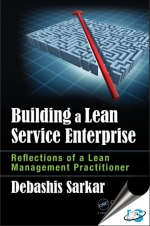Tab Article
This book provides an assorted set of reflections/lessons from the "trenches" of Lean service and brings to fore leadership challenges, new tools, and the known-unknowns (insights that very few know but many in journey of Lean transformation need to know). Lean has the ability to address a wide range of problems faced by service companies, such as: complexity reduction, sales force productivity enhancement, operations risk control, cost leadership, combining scale with flexibility, service excellence and improving employee morale and involvement. Many of the principles discussed in the book are based on the author's first-hand experience in Lean implementation.
- The only current book to bring out lessons from actual Lean service initiatives
- Contains host of new tools developed and successfully used by author in Lean transformations
- Brings out leadership challenges encountered in Lean service deployment
- Provides Do’s and Don’ts that must be kept in mind on a journey of service Lean adoption
- Written in a jargon-free and easy-to-read manner so that the book can be read by both Lean change agents and those uninitiated to Lean thinking


